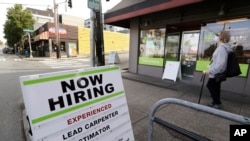Another 1.5 million laid-off U.S. workers filed for unemployment compensation last week, the lowest figure in three months, the Labor Department reported Thursday, as many American employers continue to slowly reopen their businesses after the coronavirus pandemic forced their closure.
The number of workers seeking jobless benefits has now dropped for 12 straight weeks, but key U.S. economic officials are predicting that the country’s recovery from the pandemic will take a lengthy period, extending well into 2021.
In all, 44 million workers have filed for unemployment compensation since mid-March, more than a quarter of the U.S. labor force of 164.6 million. But the number currently receiving benefits has dropped to 20.9 million as millions of workers have now returned to their jobs.
The official U.S. jobless rate was 13.3% in May, although officials say that when a survey error was accounted for, the rate should have totaled 16.4%.
The Federal Reserve, the U.S. central bank, predicted Wednesday that the U.S. unemployment will fall to 9.3% by the end of this year and to 6.5% by the end of 2021, a rosier advance than some economists are forecasting.
Fed Chair Jerome Powell acknowledged the continuing employment hardship for millions of Americans.
“Unemployment remains historically high,” he said at a news conference. “The downturn has not fallen equally on all Americans. The rise in joblessness has been especially severe for lower wage workers, women, African Americans and Hispanics.”
The Fed, at the end of a two-day policy meeting, said, “The ongoing public health crisis will weigh heavily on economic activity, employment, and inflation in the near term, and poses considerable risks to the economic outlook over the medium term.”
With mass protests, including numerous chaotic clashes between demonstrators and police roiling the U.S. in the past two weeks in the wake of the May 25 death of a black man, George Floyd, while in police custody in Minneapolis, Minnesota, the plight of the unemployed has garnered far less attention in recent days.
Lawmakers in Congress and the White House have been weighing whether more government aid to workers and American families is needed to speed the economic recovery.
Treasury Secretary Steven Mnuchin told Congress on Wednesday, “I definitely think we are going to need another bipartisan legislation to put more money into the economy.”
House Democrats have approved about $3 trillion in new spending, which would provide more aid for states and cities, among other things. But Senate Republicans and the White House have rejected the plan and are considering other options to boost the economy.
One idea is to send cash to workers who return to their jobs, perhaps $1,200, to remove them from the millions of people collecting unemployment compensation.
The U.S. death toll from the virus has now topped 113,000, by far the most in the world, and health experts predict tens of thousands more will die in the coming months. But President Donald Trump, facing a November re-election contest against former Vice President Joe Biden, is predicting the country will have a robust economic recovery.
Trump almost never publicly mentions the devastating unemployment numbers, instead predicting a speedy economic recovery and citing robust stock market gains.
“NASDAQ HITS ALL-TIME HIGH. Tremendous progress being made, way ahead of schedule. USA!” he tweeted Wednesday.
But with new fears of the spread of the coronavirus and a prolonged economic recovery, U.S. stock indexes fell sharply on Thursday. The widely watched Dow Jones Industrial Average of 30 blue-chip stocks was down nearly 7% at closing and the technology-heavy Nasdaq index cited by Trump by more than 5.2%.
The coronavirus has had a major effect on U.S. commerce, with more than two dozen companies filing for bankruptcy protection in May and some companies announcing they were closing permanently.
The government says the national economy dropped 4.8% in the first quarter, but that was before the full impact of the pandemic became apparent for the April-to-June quarter.
Numerous states still require social distancing of at least two meters between people in stores and some major retail outlets are requiring their employees and customers to wear face masks. Some governors are limiting restaurants to half capacity or only allowing out-door eating with appropriate social distancing.
But in other states, the restrictions have been significantly lifted and crowds have quickly emerged to resume life, shopping or enjoying a day at Atlantic and Pacific beaches, often ignoring the admonitions of health experts to maintain a safe distance from others or to wear a face mask.
Tens of thousands of people filled the streets of cities large and small to protest the death of Floyd, not all of them wearing face masks.
U.S. workers filing for jobless benefits normally are paid slightly less than half their normal salaries. But these payments are currently being augmented during the pandemic with $600-a-week supplements from the federal government for four months, through July.
The peak of the unemployment benefit claims likely came in late March with 6.9 million workers filing for the jobless compensation in one seven-day period.
But the millions of claims have still been unparalleled over decades of U.S. economic history, reaching back to the Great Depression in the 1930s. The number of claims has far exceeded those made during the Great Recession in 2008-2009.





